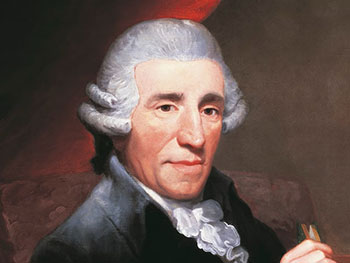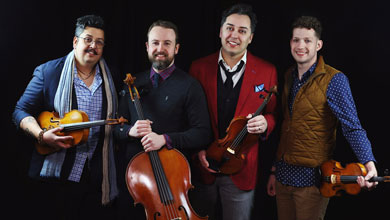Program
Johann S. Bach
Contrapunctus I from The Art of Fugue, BWV 1080
Franz Joseph Haydn
String Quartet in G minor, Op. 74 No. 3, The Rider
Johannes Brahms
String Quartet No. 1 in C minor, Op. 51, No. 1
Beo String Quartet
The Beo String Quartet made an auspicious New York debut in 2023 at the distinguished Morgan Library and Museum. “These days one expects exact intonation and clear articulation from quartets…The Beo Quartet had all that technical facility, to which they added a sound that was grainy with a touch of velvet.” — The New York Classical Review
Program Notes
Johann Sebastian Bach (1685-1750)
Contrapunctus No. 1 from "The Art of Fugue,” BWV 1080 (1742-1749)
Performance time: 3’
George Frideric Handel’s “Messiah” first performed in Dublin (1742); Thomas Jefferson born (1743); Henry Fielding’s comic novel The History of Tom Jones, a Foundling is published (1749).

J.S. Bach (1685-1750)
Ryan Ash, cellist of the Beo Quartet (currently on paternity leave), was generous enough to offer the following personal notes on this work.
“Of the six or so major works Bach composed in his last ten years (including “The Well-Tempered Clavier,” “Goldberg Variations,” “Mass in B minor,” etc.) one could make the case that “The Art of Fugue” really is the hardest to swallow out of these famous pieces. Fourteen fugues, four canons, all in the same key, all based on the same melodic material, all in a row...would that not be a bit much for an unsuspecting concertgoer?
“But “The Art of Fugue” isn't like other works. It's lifetime music. I've been getting to know it little by little, year after year, and it's always still around when I'm ready to learn a little more. It doesn't suffer when we experience it in short bursts; in fact my colleagues and I find performing just one or a few of the fugues to be very effective. You'll be hearing one of the Fugues today.
“There's lots of brainy, technical genius packed into “The Art of Fugue” that the professional (and the curious) can find. But despite the intellectual rigor (and all the alarming sameness mentioned above), each fugue is alive with its own mood, character, and personality—more than enough for the concert stage!
"There's another reason we're tackling these pieces. Fugue is music wherein each musical line is equally independent and interesting on its own, yet all the parts must work together to weave the whole sound. Should you find such a balance between four independent individuals, you just might have yourself a string quartet. Happy listening!”
Here are two interesting performances of this selection. The first is by Glenn Gould (solo piano); the second is by Art of Brass Vienna (brass quintet) These two vastly different performances and performers demonstrate how easily this music can be interpreted in several different musical mediums.
Franz Joseph Haydn (1732-1809)
String Quartet in G minor, Op. 74, No. 3, “Rider” (1793)
Performance time: 20’
In 1793, King Louis XVI and Marie Antoinette were guillotined and the French Reign of Terror started; yellow fever epidemic hit Philadelphia, killing 10% of the population; the first Fugitive Slave Act passed, providing for the seizure and return of runaway slaves.

Franz Joseph Haydn (1732-1809)
In 1790, Haydn essentially retired with a pension from his decades-long service as Kapellmeister to the imperial Hungarian Esterházy family. He soon made arrangements with the impresario Johann Peter Salomon to travel to London where he was fêted as the greatest living European composer. At the height of his powers, Haydn’s symphonies and string quartets were performed before huge public audiences in a large theatrical setting, a far cry from the exclusive but very isolated Esterházy salon. Inspired by this grandeur and recognition, Haydn composed a fresh series of symphonies and string quartets, during what can be called his “London Years.” These quartets in particular were received with great acclaim. With their more exaggerated emotional content marked by harmonic contrasts, easily identifiable melodies, brilliant part writing and faster tempos, here was music that the public enthusiastically grasped. This new approach is particularly evident in six string quartets (op. 71 and 74) he wrote back in Vienna in preparation for a second trip to London. Undoubtedly, the most famous quartet of the six is the one we will hear today.
This quartet uses Haydn’s favored four-movement design. The two outer movements are cast in what is commonly known as “sonata form,” involving three sections. The first section presents the main musical themes. The second section makes a dramatic play on these themes’ music like a “jam session” full of references, digressions and entertaining surprises. The final section returns to the restatement of the themes but elaborated and transformed for a more powerful sense of resolution. Because it is written in a minor key, Haydn’s “Rider” offers an especially vivid opportunity to experience the form, twice. In both the opening and final movements, the first theme is in a minor key and the second is in a major key.
Between these sonata-form bookends, Haydn offers one of his most luminous and touching slow movements, followed by a minuet. Haydn’s publisher must have recognized the special qualities and appeal of this movement, since he also published it in five different piano arrangements. The slow section features a hymn-like songfulness that waxes radiant with a careful tempo, brilliant harmonies and rich embellishments the second time around. The middle section, in minuet form, contrasts the song with a spirited dance and its inner trio. And to wrap up the whole piece, we have the powerful Finale, where the music turns from the minor to the major mode and then proceeds into a wild gallop at the end, giving the quartet its nickname “The Rider.”
Continuing our exploration of historical performances that have made significant contributions to the standard corpus of chamber music, here is the Amadeus Quartet performing this work in 1957. The Amadeus Quartet was one of the most important string quartets of the twentieth century, with an interesting history. Three of the players were Viennese émigrés who moved to the UK to avoid persecution from the Nazis. They first met while they were held as enemy aliens in various internment camps across the UK, most notably in the Isle of Man.
Johannes Brahms (1833-1897)
String Quartet in C minor, Op. 51, No. 1 (1873)
Performance time: 28’
In 1873, Jules Verne publishes Around the World in 80 Days; Remington starts production of first practical typewriter; P. T. Barnum's circus, "Greatest Show on Earth," debuts.

Johannes Brahms (1833-1897)
To quote Melvin Berger, “to the listening public of the day, Brahms was the musical heir of Beethoven—a burden he did not bear easily. Brahms wrote, ‘You do not know what it is like, hearing [Beethoven’s] footsteps constantly behind me.’ It is, therefore, not surprising that the two forms in which Beethoven produced such enduring masterworks, the string quartet and the symphony, were precisely those in which Brahms felt the greatest pressure to measure up to his model. Consequently, he wrote and destroyed some twenty string quartets and then spent about two decades revising and polishing his first quartet before he allowed it to be published.”
This is the quartet that we hear today, the work that Brahms offers as his opus which he hopes is worthy of comparison to Beethoven. The first movement starts with an intense opening, with complex counterpoint, dramatic pauses, and forceful repeated notes. There is a notable balance between all four instruments, as well, each having their own lyrical moments The second movement, Romanze, is marked with the sadness, longing and disappointment that marked Brahms’s own life. The opening personal and pensive melody is followed by a short contrasting section, with the opening melody returning to close this painfully elegant movement. The third movement is made up of a series of self-contained but melodically related episodes, creating a gentle, good-humored “song without words,” with the opening episode returning to close out the movement. The tempestuous Allegro finale uses the same material as the opening melody of the first movement, and resembles the entire movement in its vehemence and passion. The movement concludes with an extended coda. This quartet is the epitome of late Romantic ensemble music: a complex, gorgeous, passionate, masterpiece that certainly stands comparison to Beethoven.
Here is a performance of this work by the renowned and recently disbanded Emerson Quartet. I was drawn to this particular YouTube performance because not only does it have the score to follow, but it also provides a detailed, measure-by-measure analysis of the work which may well be of interest to the many musicians in the CCMS audience.
Program Notes by Louise K. Smith
With thanks to Ryan Ash, Kai Christiansen, Melvin Berger, Lucy Miller Murray and Nancy Monsman.
We cordially invite anyone interested in helping to select YouTube performances to include in our notes next year to contact me directly at louise_smith@mac.com. It is a wonderful way to get really involved with the music—please do consider it!

Beo String Quartet
Subscribe
Today!
Individual tickets may be purchased at the door (cash or check only) immediately before each concert.
All concerts are held at a private club just off Michigan Avenue in Chicago.
Call or email for more information
815-314-0681
office@ChicagoChamberMusicSociety.org